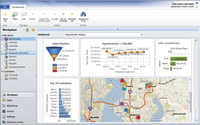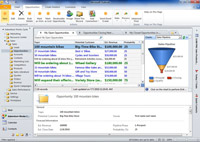In-Depth
Dynamics CRM Facelift Brings Confidence to the Channel
Partners like Jeffrey Goldstein are eager for features in Microsoft's forthcoming release that will give them better traction against Salesforce.com.
- By Jeffrey Schwartz
- September 01, 2010
Microsoft is doubling down its effort to get channel partners to sell more of its Dynamics CRM software. Armed with a new release with several key new features and improved margins for those selling the online version, Microsoft is gunning to beat perennial leader Salesforce.com Inc. at its own game.
While the company is readying some substantive and long-awaited improvements to the forthcoming Dynamics CRM 2011 (formerly code-named "CRM 5"), which goes to beta this month and ships by the end of this year, some partners say getting customers to look beyond Salesforce.com is an uphill battle.
"I just went on a call for CRM and the VP of sales just keeps pushing Salesforce, Salesforce, Salesforce and he'll find a flaw in anything else no matter what you implement," says Jeffrey Goldstein, managing director of New York-based Queue Associates Inc., a Gold Certified Partner. Making matters worse, "the owners of the business won't fight the battle."
Forrester Research Inc. analyst William Band says while Microsoft Dynamics CRM has gained appeal, outpacing Salesforce.com could be a high bar to clear. Salesforce.com last year reported $1.3 billion in revenues. Microsoft by comparison grossed about $300 million, Band says. Microsoft doesn't release Dynamics CRM revenues. With the customer relationship management market pegged at about $12 billion a year and growing at a mature rate of about 6 percent to 8 percent, catching Salesforce.com could be a tough task, Band says.
"In order for Microsoft [Dynamics] CRM to become a billion-dollar business, the market has to grow more or somebody else has to lose a lot of market share," Band says. "I don't know that there's that much space in the marketplace for Microsoft CRM to get that big. I don't know where another billion would come from."
A further source of frustration for Goldstein is the $44 per month price tag for Microsoft Dynamics CRM Online, which he says is far less expensive than Salesforce.com, yet customers aren't swayed by that. Price and feature comparisons are not the issue, Goldstein says. "The problem we run into is so many VPs of sales and ex-sales people just have a history with Salesforce. They just ask for it by name and they just refuse to use anything else," he says.
Dynamics CRM 2011 looks to erase much of the objections to competitive offerings. It will have support for improved data visualizations, real-time dashboards and cloud development. Perhaps its most important new feature is an online marketplace that will let partners and customers find, download, and implement custom and packaged extensions for Dynamics CRM.
"Partners will be able to build, package and upload their solutions, customers can discover, download and deploy these solutions both on-premises and in the cloud," says Brad Wilson, general manager, Microsoft Dynamics CRM.
"The online marketplace is going to help make it more competitive, especially against Salesforce," Goldstein says. "That was one of the major limitations with CRM Online, you had to use it out-of-the-box and you couldn't use any third party applications -- you couldn't do any heavy customization," Goldstein explains.

[Click on image for larger view.] |
| Users will be able to create inline data visualizations and charts that allow for further drill-down access to data. Customers can also configure real-time dashboards to track business performance. |

[Click on image for larger view.] |
| CRM content will work within the native Outlook interface. The Ribbon aims to provide consistent Office navigation. |
Best of Both Worlds
Microsoft is making a strong push for partners and customers to give Dynamics CRM Online a try. To incent partners to push customers to Dynamics CRM Online, the company is offering a 40 percent margin for the first year for each seat it sells.
"That's absolutely huge. Partners will be crazy to not want to try and sell CRM, even those that haven't sold it before," says Kevin Wydra, CTO of Client Profiles Inc., an ISV based in Atlanta.
In fact, in an atypical move, Microsoft is releasing the online version first and is set to release the premises-based software early next year. The goal is for the two versions to work hand-in-hand, allowing those in the field to take advantage of the Web-based features and those in offices to use the premises-based version.
Because it supports the Microsoft .NET Framework 4 and Windows Communication Foundation (WCF), Dynamics CRM 2011 will be appealing to those who want to integrate it with existing .NET Framework-based apps and the rest of the Microsoft software portfolio. Goldstein says what's nice about having a fully featured online version is customers can work with that first, without having to deploy anything internally.
"What I tell my prospects is: 'Listen, try it for a year,'" Goldstein says. "'If you like it, and you think it's the greatest thing in the world and you want to bring it in-house, and then start integrating it with your other systems and customizing and modifying it, then we just pick the database up and we move it. But if you like it the way it is and where it is, then you just leave it."
Goldstein continues: "When Microsoft does this, they give you the best of both worlds. So if you want to run it on-premises, you can run it on-premises; if you want to run it hosted, you could run it hosted; if you want to rent it you can rent it; if you want to buy it you can buy it. Between those four combinations, we can always come up with something that will fill the customer's needs."
New Business Model
Goldstein is among those partners who are bullish on the move to the cloud even though he knows the revenue per customer is substantially less. With the premises-based version of a product like Dynamics CRM, Goldstein says the typical enterprise pays $1,000 per user for services and implementation.
That doesn't fly when the cost per user for Dynamics CRM Online is only $49 per month, he readily points out. And that's where he changed his business model. Queue Associates launched what's called a Quick Start program, designed specifically for customers who want Dynamics CRM Online only, yet require some level of service to get it off the ground.
The Quick Start program comes at a flat rate of $5,000 regardless of the number of users. It's a three-day implementation and training program. "The rule in data processing is you always pay 2-to-1 for services versus software," he says. "We had to come up with a way to put our services more in line with the online offering so that they're cost-competitive. Someone is not going to pay $49 a user a month for 20 users and then pay $20,000 for implementation. They're just not going to do it. It's crazy. It defeats the whole purpose of CRM Online."
But can a solution provider actually make a profit selling Dynamics CRM Online and offering implementation services for just $5,000? Goldstein says yes, because there's a much lower cost in delivering the service, plus it comes with the recurring revenue after the fact.
"What we do is a three-step process: Identify the requirements, configure the system and train," he explains. "I don't have to do installation, integration with their environment; I don't have to worry about what they're running or deal with Active Directory, so that makes it simpler because [those make up] half the problem with installing CRM in their environment."
Because of the differences in service delivery and costs associated with it, Queue Associates now has two sides of the business, one for implementing traditional software and another for the online offering.
Weathering the Online Transition
Goldstein admits it's been painfully slow: last fiscal year ended June 30, 2010, with only four customers signed on, and they were for other Dynamics ERP products. While he has some Dynamics CRM customers in the pipeline, none have signed on as of early August. But he believes that will change rapidly with the new release of Dynamics CRM 2011. Overall, 5 percent of his business is hosted -- a figure he anticipates will grow to 10 percent by this time next year.
"Eventually it will be 100 percent of our business, we have to go through the transition," he says. "It's probably going to take five to 10 years to get there, but it's going to be a large percentage. Microsoft is going to make it so that it's cost effective to do it that way. We have no choice, the handwriting is on the wall."
Wydra agrees: "I can honestly now tell you -- I wouldn't have said this a year ago -- but we're seeing more and more firms that are looking at the return on investment for this model, because the cost of managing all that hardware and continuing to have to manage and replace that hardware every X number of years, that gets expensive," he explains. "So they're looking at it now."
Indeed, Forrester's Band says those products that have shown growth lately are Oracle CRM On Demand, Salesforce.com and Microsoft Dynamics CRM Online. "The guys who are declining are Oracle's Siebel, SAP and the traditional on-premises players," Band says.
One of Band's biggest criticisms of the current Microsoft Dynamics CRM Online offering is its lack of penetration in foreign countries. Microsoft has announced that by the end of the year, it will be available in 40 markets and 41 languages. Among those markets Dynamics CRM will enter are Brazil, Colombia, Costa Rica, Chile, Cyprus, Peru, Trinidad and Tobago, Microsoft says.
Wilson says there will be broad support for Europe, the Middle East, Africa and Asia as well. "That's a big thing for us to bring this online service around the world," he says.
For his part, Wilson believes Dynamics CRM 2011 will give Salesforce.com a run for its money. Its support for developer code is a major equalizer, he said. But more important is the fact that customers can choose to have both premises-based software and the Dynamics CRM Online versions of the product.
"With the new release we're going to offer full custom code on the server abilities so all the techniques that our partners have to help solve customer needs will be fully symmetric between on-premises and in the cloud," Wilson says. "So in other words, it lets us help our partners take the gloves off and use all of their skills, their Silverlight skills, their .NET skills all in the cloud."
Client Profiles' Wydra, whose company implements case management software used by law firms to manage their entire client workloads, has integrated his software with Dynamics CRM. Wydra has already seen the pre-beta of Dynamics CRM 2011 as a member of the Microsoft Technology Adoption Program (TAP) and likes what he sees.
"They spent a tremendous amount of time between version 4 and CRM 2011 making sure that the approach that they were giving to developers from an API and SDK perspective was something that we could develop on a pattern," he says. "So we could develop it one way and it would just work whether it was an on-premises installation or an online installation."
"The biggest change we see for CRM 2011," Wydra says, "is the fact that they've provided the ability for these custom solutions with custom development that can be deployed in an on-premises as well as online scenario."